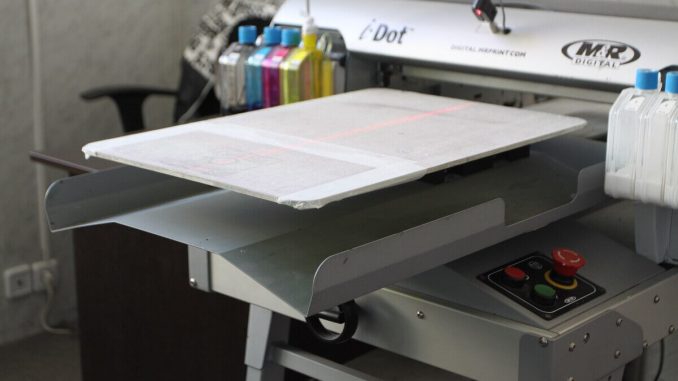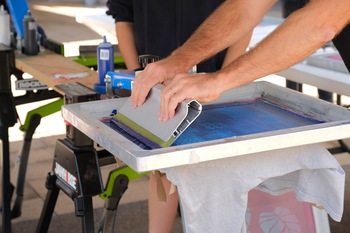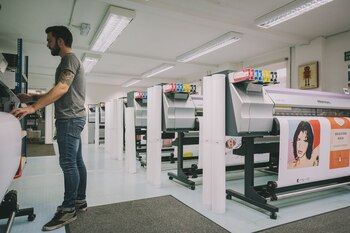
When it comes to printing custom designs on clothing, promotional items, or signage, the two most common methods are screen printing and digital printing. Each technique has its own strengths and weaknesses, making one better suited for certain projects than the other. Understanding the differences between these two printing methods is crucial for businesses, designers, and consumers who want to achieve the best results for their needs. In this article, we’ll break down the key differences between screen printing and digital printing, discussing their benefits, limitations, and ideal applications.
 What is Screen Printing?
What is Screen Printing?
Screen printing, also known as silkscreen printing, is a traditional printing method that involves creating a stencil (or screen) for each color in a design.
Ink is then pushed through the stencil onto the material using a squeegee, transferring the design onto the fabric or substrate.
Screen printing is widely used for creating bulk orders of custom apparel, such as T-shirts, hoodies, and bags.
Benefits of Screen Printing
- Vibrant Colors: Screen printing excels at producing bright, opaque colors, especially on darker fabrics. Since thicker layers of ink are applied, the colors are more vivid and durable.
- Cost-Effective for Bulk Orders: Once the screens are made, the cost per item decreases significantly as the number of items increases. This makes screen printing highly economical for large batches.
- Durability: The thicker layers of ink applied during screen printing are highly resistant to wear, washing, and fading, making it an ideal choice for items that need to withstand frequent use.
- Versatility: Screen printing can be applied to various materials beyond fabric, such as plastics, glass, and metal. This makes it a versatile method for creating printed designs on promotional products like mugs, bottles, and signage.
Limitations of Screen Printing
- Complex Setup: Screen printing requires creating a separate stencil for each color in the design. This makes the setup process more time-consuming and labor-intensive, especially for multi-color designs.
- Not Ideal for Small Orders: Due to the complex setup process, screen printing is not as cost-effective for small orders. For example, if you only need a few custom T-shirts, the setup cost may outweigh the benefits.
- Limited Color Options: Although screen printing excels at producing solid, vibrant colors, it has limitations when it comes to intricate designs with many colors or gradients. Each color requires a separate screen, making it difficult to reproduce highly detailed images with shading or photographic quality.
What is Digital Printing?
Digital printing, also known as Direct-to-Garment (DTG) printing, is a more modern method that uses specialized inkjet printers to apply ink directly onto the fabric or material. This method is often compared to printing on paper using a regular printer, except it’s done on textiles or other substrates.
Benefits of Digital Printing
- Great for Detailed Designs: Digital printing is capable of producing highly detailed images, including designs with gradients, shading, and fine lines. This makes it the go-to choice for reproducing complex artwork, photographs, and illustrations.
- No Setup Costs for Small Orders: Since digital printing doesn’t require the creation of stencils or screens, the setup process is much faster and easier. This makes digital printing ideal for small orders or one-off items, such as custom T-shirts for events, gifts, or product prototypes.
- Unlimited Color Options: With digital printing, there’s no need to worry about color limitations. It can handle a wide range of colors and reproduce intricate details with precision, thanks to its advanced technology.
- Faster Turnaround for Short Runs: Without the need to create stencils and screens, digital printing offers a quicker turnaround time for short runs. This makes it an excellent option for customers who need customized products in a hurry.
Limitations of Digital Printing
- Less Durable: Compared to screen printing, digital prints tend to be less durable over time, especially after multiple washes. The ink penetrates the fabric rather than sitting on top, which can lead to fading or cracking more quickly than screen-printed designs.
- Limited to Certain Materials: Digital printing is best suited for fabrics like cotton and other natural fibers. It doesn’t work as well on synthetic fabrics or harder surfaces like plastic, metal, or glass.
- Not Cost-Effective for Large Orders: Digital printing can become more expensive for larger orders since the cost per unit remains relatively constant. It is generally more cost-effective for small to medium-sized batches rather than bulk printing.
Screen Printing vs. Digital Printing: A Side-by-Side Comparison
| Criteria | Screen Printing | Digital Printing |
|---|---|---|
| Best For | Bulk orders, simple designs | Small orders, complex designs |
| Color Vibrancy | High, especially on dark materials | Good, but not as vibrant as screen printing |
| Durability | Highly durable, withstands washing | Less durable, may fade over time |
| Setup Time | Longer setup time due to screen creation | Short setup time, no screens needed |
| Cost Efficiency | More cost-effective for large orders | Better for small orders or one-offs |
| Color Range | Limited to a few solid colors | Unlimited color options, good for gradients |
| Material Versatility | Works on many materials (fabric, glass, metal) | Limited to fabrics (mostly cotton) |
| Turnaround Time | Longer for small runs, faster for large runs | Quick for small orders, slower for bulk |
Which Printing Method Should You Choose?
The choice between screen printing and digital printing depends on your specific needs, including budget, design complexity, and the type of material you are printing on. Here are some general guidelines to help you decide:
 When to Choose Screen Printing
When to Choose Screen Printing
- Bulk Orders: If you need a large quantity of items printed, screen printing is the more economical option.
- Simple, Bold Designs: If your design has a few solid colors without intricate details, screen printing will provide vibrant and durable results.
- Durability Matters: For items that will be worn or used frequently, such as work uniforms or sports apparel, the long-lasting durability of screen printing is an advantage.
When to Choose Digital Printing:
- Small, Customized Orders: For one-off items or small runs, digital printing offers convenience and cost-efficiency.
- Complex, Detailed Designs: If your design involves multiple colors, gradients, or intricate details, digital printing is the best choice to capture the nuances.
- Fast Turnaround: Digital printing is perfect if you need your custom items quickly, such as for last-minute events or marketing campaigns.
Conclusion
Both screen printing and digital printing have their advantages and disadvantages. Screen printing offers vibrant, long-lasting prints and is more cost-effective for large orders, but it can be limited in terms of detail and color range. Digital printing, on the other hand, excels in producing intricate, colorful designs with a faster setup, making it ideal for smaller or more complex projects. By understanding the key differences between these two methods, you can make an informed decision that best suits your project’s needs and budget.

Leave a Reply